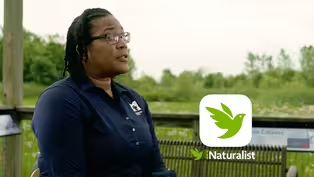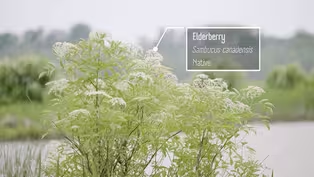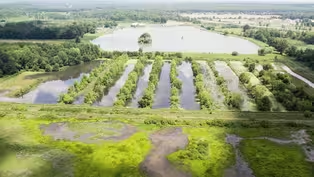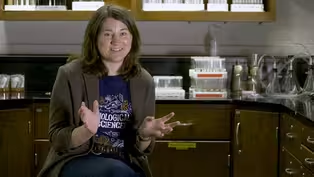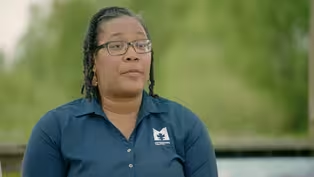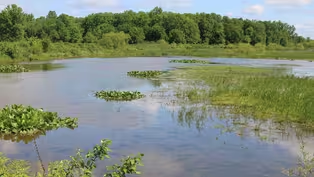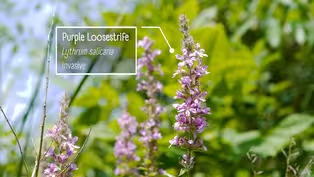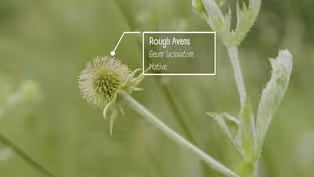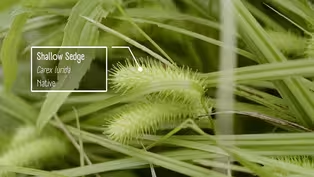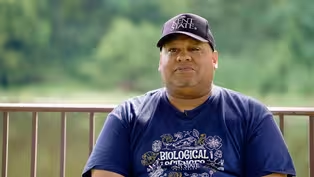
Native & Invasive Species of the Wetlands
8/22/2025 | 26m 39sVideo has Closed Captions
Get a closer look at the native and invasive species of our wetlands.
Explore wetlands in this close look at the flora and fauna in and around the ecosystem. With the help of more local experts, learn about the essential role of native species, the destructive force of invasive species, and the importance of protecting biodiversity in our wetlands.
Problems playing video? | Closed Captioning Feedback
Problems playing video? | Closed Captioning Feedback
By Nature’s Design: Exploring Our Native Wildlife is a local public television program presented by PBS Western Reserve

Native & Invasive Species of the Wetlands
8/22/2025 | 26m 39sVideo has Closed Captions
Explore wetlands in this close look at the flora and fauna in and around the ecosystem. With the help of more local experts, learn about the essential role of native species, the destructive force of invasive species, and the importance of protecting biodiversity in our wetlands.
Problems playing video? | Closed Captioning Feedback
How to Watch By Nature’s Design: Exploring Our Native Wildlife
By Nature’s Design: Exploring Our Native Wildlife is available to stream on pbs.org and the free PBS App, available on iPhone, Apple TV, Android TV, Android smartphones, Amazon Fire TV, Amazon Fire Tablet, Roku, Samsung Smart TV, and Vizio.
Providing Support for PBS.org
Learn Moreabout PBS online sponsorship(serene music) (birds chirping) - [Mark] Wetlands are a vital ecosystem in our landscape.
The wildlife that live among them can either make or break the system.
Native and invasive species are having an unseen battle for survival in the wetlands.
Who will win?
And how does this battle affect the surrounding area?
(upbeat music) This is "By Nature's Design".
(gentle upbeat music) "Native and Invasive Species of the Wetlands".
(birds chirping) Wetlands is kind of a generic term that we use for lots of lots of different kinds of ecosystems that people are probably used to hearing called swamps or bogs or marshes those are all kinds of different wetlands.
Legally and and scientifically, there’s three criteria that a area of land has to meet to be called a wetland.
It has to have water, some or all or part of the year, so it is wet land.
It has plants that are specially adapted to survive under flooded conditions.
So to be a wetland it has to have wetland plants, and it has to have soils that bear that signature of having been wet.
So to be a wetland it has to have wetland plants, have wetland soils, and be wet land.
In practice, it ends up being shallow areas that is not deep enough to be a lake.
It’s not dry enough to be a grassland or a forest.
It ends up being these kinds of in the middle marshy, mucky, shallow wet places.
(birds chirping) (light upbeat music) - What makes a wetland though is the hydric soils, the hydrology of an area and the plants that occupy that wetland system.
When you have those forested wetlands, when you think of swamps, the trees tend to be present, but when you have more like a marsh system, you tend to have areas of open water intermixed with those areas where it's a little bit more terrestrial so that plants can grow as well.
(birds chirping) (gentle music) When you think about the ecosystem services that native species provide to wetlands, one of the first terms that comes to mind is that "Wetlands are nature's kidneys," and there's a water quality aspect that we think of when it comes to wetlands.
As sediment enters the system, it's able to settle out in that system, thus improving the water quality.
And there's also an air quality aspect as well, because you have plants that exist within that system, whether it's trees or herbaceous plants.
So these different types of services that benefit wildlife and people are what wetlands provide.
(gentle music) (birds chirping) - [Mark] The unique benefits that wetlands provide are what make them vital to the landscape.
Plants and animals rely on this ecosystem for food, water, and habitation.
(gentle music) Meanwhile, the species occupying the wetlands play a role in the sustainability of the area.
(gentle music) For a wetland to function properly, there are components, such as native species, that help the wetland thrive.
(serene music) - A native species is one that has evolved over time to exist within the local ecosystem.
So a species like, I'll say eastern cottonwood for example, has over millennia become adapted to the local wetland system compared to a non-native or an invasive species that has come from another area of the world often outcompeting our native species that are here.
(light instrumental music) - So generally, the wetland ecosystem has developed around these native species.
It's a synergistic effect, meaning the species that are there have certain effects that they put on the wetland, such as they live somewhere, they reproduce somewhere, they eat somewhere, and so the wetland develops around that and adapts.
Then they in turn adapt to how the wetland has responded to their actions.
Beavers they use native species to build their dams and other structures, so they're going to be out looking for native plants.
Without those, they wouldn't be able to do what they do.
(gentle piano music) - [Mark] The elderberry plant provides cover and habitat for numerous species.
For example, the plant creates overhanging banks that provide habitat for aquatic organisms.
The berries it produces are also a great source of food for species such as birds and deer.
Native species, such as this one, are important to maintain because of their ecosystem benefits.
- You have a system that has evolved over time to exist in a way that can be resilient to disturbances.
Wildlife in the area are now like adapted to that particular wetland system and those plants have often evolved in tandem with the wildlife species, such that their life cycles are dependent on wildlife and/or vice versa.
And so we want to maintain these systems for our native species, both plants and animals, so that they can persist into the future for all these species that we've come to know in Ohio and specifically this portion of Northwestern Ohio.
(gentle music) (birds chirping) - [Mark] Native species of the wetlands are important to the lifecycle of other wildlife.
Native plants such as shallow sedge and arrow arum plants play an important role in the ecosystem.
Shallow sedges provide food through seeds and is a place of cover for wildlife to nest in.
(gentle music) It helps the wetland by cleaning and cooling the water.
This species is also a host plant for native pollinators, who rely on it to lay their eggs.
(gentle music) From roots to foliage, the native arrow arum plant also supports the wetland.
Its roots knit together and stabilize submerged sediments, while its foliage creates a deflecting barrier from any harsh water movement.
(gentle music) - Once you start losing native species, the wetland is going to start to change and might eventually not be a wetland.
The analogy I think of is if we think of our bodies as human bodies.
We're systems, and we think of, you know, "What do we need to run at our maximum health?"
We probably need a certain amount of sleep.
We need good food, so to speak.
We need exercise, so same with a wetland.
It needs certain components, and one of those components are native species.
And just like a person, if you start getting sleep deprived or you eat junk food, so to speak, there's going to be an effect down the road on your body, so same with the wetland.
Start removing species, native species, and there's going to be an effect down the road.
(bright upbeat music) (birds chirping) - When you think about the role that native species play in an ecosystem, they often work in tandem to create a resilient system.
So you have your plants operating in one space, and then your wildlife operating in a different space.
When a system experiences disturbances, if you have your native species that are present, the ecosystem can bounce back from that disturbance and continue to operate.
(gentle music) - [Mark] Native species are key to an ecosystem's ability to bounce back from disturbances.
When wetlands experience a disturbance that causes native plants to die out, the native wildlife will leave, decreasing biodiversity.
Biodiversity is essential to the wetland ecosystem because it creates a resiliency.
Native species, such as rough avens and buttonbush, help maintain the biodiversity of an area.
They draw beneficial insects such as bees and butterflies by providing energy and being a source of pollination.
(gentle piano music) These native plants also help with erosion control along the shorelines to protect the stability of the wetland.
(birds chirping) Technically, ecologically, when we think about diversity, we think not only about just the number of species just making a list.
That’s what we call a richness.
So let’s say there’s ten different plant species in a field behind your house.
That’s not the only thing that ecologists consider when they think of how diverse a system is because maybe of those ten species, you look out at that field, and all you see is one species.
And the other nine are just in one little corner or they pop up here and there.
As opposed to looking at that field, and seeing ten different species throughout the field.
We call that evenness.
So the relative abundance of the different species.
So we have these indices that we calculate based on adding up how many individual species are present and then how much of each of them are there.
That’s the relative abundance.
So those are both components of what we call biodiversity.
for these wetland ecosystems because many of these species, whether plant or animal, have a mutualistic relationship and have evolved over time to be dependent on each other.
So we have birds that are coming through, and they're looking for food.
Having a diverse amount of food, then helps that species to continue to persist.
Having the nutrients that they need to make the trek across Lake Erie or to be able to breed where they are.
(light upbeat music) - You know, it's typical what we call natural resource management.
What kind of nature do we want?
This is a pond and wetland, but how much of each?
And what was before is that what it should be?
And these are questions that, you know, we need more than one person.
We need a number of people and stakeholders, such as the people who walk this track every day.
What do they like to see?
Classes come down here.
What do they need to see to do their assignments, and so on and so forth.
(light upbeat music) It's native species that keep the wetlands the way we expect them to be.
(light upbeat music) - [Mark] There are some native species that act as invasives do, taking over an area and outcompeting other species.
Though they may act aggressively, they are still native species by nature.
(gentle upbeat music) Take this area of spatterdock, for example.
- [Nick] This is a case of a... - Native.
- Of a native that's very aggressive.
So spatterdock here or sometimes called yellow cow lily, has a very robust tuberous root system, spreads very quickly as you can see, and it can take over and form monocultures even though it's native.
(birds chirping) Not saying it's good or it's bad really, but some better biodiversity would be our goal for this basin here.
Right now it's about 26 acres of almost purely just spatterdock.
So we have some plans to, you know, control some of this back to hopefully allow for some other native species to come in and fill those gaps and increase biodiversity.
- It's always amazing when you see it outcompeting one of your invasive non-native species, like the narrow leaf cattail out there.
So, get a battle royale going out there.
- [Nick] Yeah, there's some sections like buttonbush and things in the center of there, but, by and large, it's almost solely spatterdock.
(gentle music) - [Mark] While spatterdock takes over the wetland ecosystem, it is not an invasive species.
A species is invasive only when it is introduced outside of its natural ecosystem causing harm to the area.
(gentle music) So an invasive speices is any creature, an organism, that is not native to this area.
So it didn’t evolve where it lands.
And on top of that, it has some kind of negative effect on the environment.
So a species that’s not from where it’s growing or living is called non-native.
For that non-native species to become invasive, it has some kind of negative effect.
So invasive is a kind of a value that we as humans put on it.
But usually it’s pretty obvious, because those negative effects tend to be taking over an ecosystem, outcompeting some of the native organisms that live there.
(light gentle music) - The presence of an invasive species can often decrease the habitat quality.
Even though we hear an abundance of birds around us right now, that's because we do still have native species that are occurring here and providing habitat.
But when you have an area that's been completely taken over by invasive species, that's a decrease in habitat quality.
So now you have a monoculture of species that are present rather than a diversity of habitat that leans itself well to a diversity of wildlife species that will also be present.
And because our native species aren't often adapted to eating or consuming or having nesting within or amongst these native species, it just isn't the quality habitat that's desirable to those or conducive to our native plants and wildlife.
(gentle piano music) An example of an invasive species that is persisting at Pearson Metropark is flowering brush.
It's one that's currently flowering, and it's outcompeting, in many cases, our native species are existing in this system.
They spread by rhizome, by seed, and spread by breaking off of their root systems.
Humans are the factors that can move species, move seeds move tiny babies of the species across oceans.
Across distances and at rates that are way faster than that species naturally would travel, right.
Species, naturally, they move into new areas.
They naturally, their ranges may change, as they adapt to new environments, or adapt to changing conditions.
A species is invasive when basically it’s hitched a ride on something it’s not supposed to like a boat or somebody’s boot or it’s brought over in a potted plant for cultivation.
(gentle piano music) - A lot of invasive plants get caught on the bottom of our boots or shoes and our shoelaces, so certainly check those.
And there's certain plants, as we know, and especially dog owners, we know there's certain plants designed to latch onto you.
You come back and you have burrs, and so check, throw those away.
I myself, I do a lot of sampling in different bodies of water, so to help prevent contamination, I clean my equipment thoroughly before I go from one site to another with a light bleach solution and distilled water.
So basically check yourself and your equipment to try to make sure you are not transporting invasive species from one site to another.
(light instrumental music) - [Mark] Invasive species such as purple loosestrife, quickly establish themselves in the landscape and force native species out.
This species is damaging to the wetland ecosystem, because it alters the structural and ecological values of the area.
While purple loosestrife may look pretty to the eye, it poses a serious threat to the wetlands.
(gentle music) (serene music) - An ideal system would not have any invasive species, Their stems form mats making the water difficult to move through for aquatic species that live below the surface.
because those species often outcompete our native species for resources and doesn't provide as quality a habitat.
And because of the presence of invasive species, no wildlife are adapted to really eating those species or keeping that at bay.
And so over time, what you have is those wildlife species may move on, and whatever plants were dependent on those wildlife species for the completion of their lifecycle, then aren't able to complete their lifecycle as a plant species.
So there's this integrated system when you think about an ecosystem where one thing depends on another, and then the absence of that thing can at some point cause the system to collapse.
And we don't want something like that.
We want to have the diversity of species here within the parks for people to be able to enjoy just for those wildlife to continue to be able to persist into the future.
That being said, we want invasive species to not be in our parks.
And so we actively manage for their removal, and we work through that by prioritizing those species, the removal of those species, that tend to proliferate quicker, such as flowering brush.
It's one of those high-priority species that spreads by multiple means and can outcompete our species very quickly.
In the case of a cattail, for example, it's here, and while we don't want it, it's actually helping us keep at bay those species that are a little bit harder to remove, such as flowering rush and/or phragmites, for example.
(birds chirping) (gentle music) - So the lilies behind me, they're an interesting situation.
They are non-native, but in most areas they are not invasive, which that's kind of funny to say seeing as they're occupying a large percentage of the water right now.
But they're generally seasonal.
They come up from the bottom, then grow, spread their lilies.
They provide protection for certain species of fish.
They provide breeding habitat.
We often see frogs on or around them.
I see insects sitting on them, so they do potentially provide a service, and generally don't take over a total wetland.
I mean, I would say with them and any other species, native or non-native, if they start physically occupying enough of the system that they're going to change it, do something about it.
(serene music) - [Mark] Though humans are one way that invasive species spread, there are things that can be done to prevent the spread from happening.
Organizations are putting effort into combating wetland takeovers through spraying chemicals, controlled burns, or just by hand pulling.
(gentle music) There are other ways to get involved independently that can help a nearby wetland, from planting native species, to making environmentally conscious decisions in daily life.
(serene music) (birds chirping) - Just one, be aware.
And two, those species oftentimes may still turn up.
Those invasive species may still turn up in some gardening centers.
And by seeing those species, you know now not to buy them and introduce them into your yard.
One of the apps that a citizen can download is called iNaturalist.
It's an app and website where people can record things that they're seeing, and it's very helpful, not just for recording of invasive species, but also for the recording of native species that are found within our parks.
It's one that I reference to see what's occurring in the area, when was it last seen?
And then there are other researchers as well who look at it at a more broader scale, of like the trends over time of species that are found and when they are found.
So download that app.
Record what it is that you see.
And a partner app to the iNaturalist is an app called Seek, where it can help you to work towards identifying the species that you're seeing by just opening up your camera through the app and pointing it at a species.
And it's a great way to learn as well.
For someone who's more newly interested in the outdoors, it's a great foot in the door because the natural world can be overwhelming with how many things are around you.
There's insects to identify plants, wildlife, lichen, all these things that you can't possibly begin to learn them all.
But that is one way that citizens can work towards helping us know what's in our parks.
(bright upbeat music) What is important to think about when you look at a wetland that’s in your yard, is it doesn’t stand alone by itself.
Really any feature on our landscape doesn’t stand alone by itself.
It’s part of a watershed.
Right?
So the place that that wetland or pond is, how water is getting into it.
If it’s only from the rain or if it’s directly adjacent to a stream or river and whenever the stream or the river floods, that wetland floods.
Maybe there’s a stormpipe that feeds water right into the wetland or a tile drain.
That is a really important thing determining what that wetland looks like, what it’s gonna do what kind of habitat it’s gonna be, what kind of filter it can be.
Just generally, when you think about any ecosystem that you see, it’s important to remember that it’s connected to other ecosystems around.
It’s not just in your postage stamp of a yard or in the field that you’re driving by.
(upbeat music) (insects chittering) - People who are concerned about biodiversity, native species, invasive species, just be aware of your surroundings.
Be aware, analyze your actions.
See if what you're doing, especially when you're enjoying nature, is that helping, hurting, or neutral?
(serene instrumental music) A problem, I don't know how pervasive it is now, but it used to be a problem that people would go into wetlands and say, you know, "Oh, that's a pretty flower," or something, and pick it and take it.
So there's a saying, "Take pictures, not wildlife," something like that.
So, for starters, don't take anything out of the wetland.
Also don't put anything in the wetland.
Sometimes people say, "Oh, well, if I just plant this," or, "I put that fish in it, "this looks like a great habitat," no.
Keep wetland plants and animals in there, and don't add anything to it.
A lot of these places are managed to keep them the way they are.
So, you know, don't litter, don't add, don't subtract.
(bright music) - [Mark] Protecting biodiversity is essential for the survival of any ecosystem.
Wetlands are an especially important ecosystem for flora and fauna alike, and keeping them functioning properly will help continue the lifecycle for these native species.
From plants on the shore and the insects that visit them, to the wetland they call home, they are all interconnected.
Discover a world that evolves and grows together "By Nature's Design".
(bright theatrical music) (bright theatrical music) - Because who needs to be at home when you can be in a Metropark?
(chuckles)
Clip: 8/22/2025 | 1m 32s | Zurijanne Cartertalks about two apps that citizens can download to help identify species. (1m 32s)
Clip: 8/22/2025 | 26s | Learn about the native Elderberry plant and the ecosystem benefits. (26s)
Importance of Maintaining Native Species
Clip: 8/22/2025 | 1m 23s | Learn about the importance of maintaining native species to the wetland ecosystem. (1m 23s)
Clip: 8/22/2025 | 55s | Lauren Kinsman-Costello defines what it means when a species is non-native or invasive. (55s)
Clip: 8/22/2025 | 31s | Zurijanne Carter defines what a native species is. (31s)
Preview: Native & Invasive Species of the Wetlands
Preview: 8/22/2025 | 30s | Get a closer look at the native and invasive species of our wetlands. (30s)
Clip: 8/22/2025 | 26s | Learn about the invasive species, purple loosestrife. (26s)
Clip: 8/22/2025 | 39s | Learn about the native species, rough avens and buttonbush. (39s)
Clip: 8/22/2025 | 39s | Learn about the native species, shallow sedge and arrow arum. (39s)
Clip: 8/22/2025 | 48s | Robert Hamilton talks about the proper practices to use when visiting a wetland. (48s)
Providing Support for PBS.org
Learn Moreabout PBS online sponsorship
- Science and Nature

Explore scientific discoveries on television's most acclaimed science documentary series.

- Science and Nature

Capturing the splendor of the natural world, from the African plains to the Antarctic ice.












Support for PBS provided by:
By Nature’s Design: Exploring Our Native Wildlife is a local public television program presented by PBS Western Reserve
